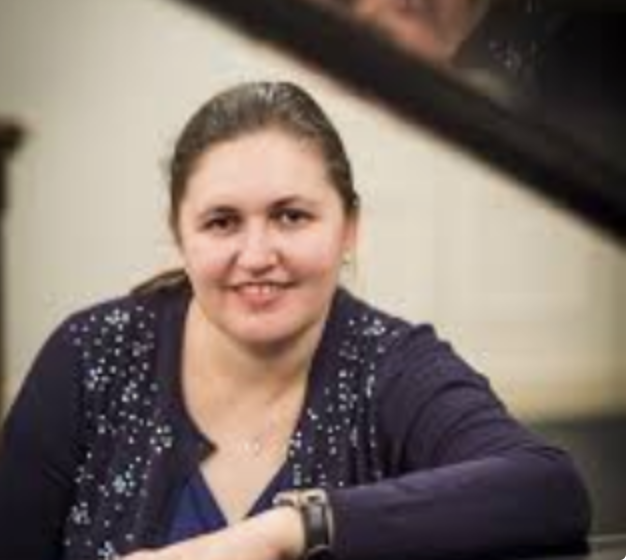Regina Shenderovich in Review
Twelve Preludes and Fugues (Nos. 13–24), Book II from
24 Preludes and Fugues, op. 87 – Dmitri Shostakovich
Regina Shenderovich, piano
Marc A Scorca Hall, The National Opera Center, New York, NY
March 8, 2024
Eventbrite advertising drew a small but attentive group of listeners to Marc A. Scorca Hall on March 8th for a rare treat: a performance of the second volume of Preludes and Fugues by Dmitri Shostakovich, a documentary project reserved for pianists of exemplary mettle and inner strength. The success of such an undertaking in a live concert also involves forging a delicate sense of trust with the audience, who must process complicated (although beautiful) details for more than eighty minutes without intermission. The pianist Regina Shenderovich, self-reliant and supremely up to the task, sat at the side of the stage until concert time, introduced her own program chattily without a shred of nervousness, and turned her own pages, emerging at the end of this test of fire as fresh as if she could quite happily have repeated the show.
Would that the life of the composer had been so unafflicted. Shostakovich spent his days in apprehensive contemplation of the fate that would befall him if the authorities should deem his music offensive or “formalist,” worthy of political imprisonment or even execution if he overstepped arbitrary creative boundaries. The favorite aesthetic insult could be interpreted and manipulated by any committee of bureaucrats; but a direct phone call from Joseph Stalin to Shostakovich overrode all threats when the Soviet Union needed a spokesperson at the Cultural and Scientific Conference for World Peace in New York in 1949. Shostakovich complied and was safe, but never recovered from his psychological scars.
The 24 Preludes and Fugues were written in 1950‐51 for the young Tatyana Nikolayeva, winner of the bicentennial International Bach Competition in 1950. Nikolayeva performed them until the very end of her life, from memory and in pairs of concerts. In 1993, I flocked to the 92nd Street Y with a cohort of students to sit bravely through both concerts of one cycle, sheepishly realizing that some preparation might have illuminated this transformative experience. Two weeks later, Nikolayeva left our world, having suffered a cerebral hemorrhage while performing the Preludes and Fugues in San Francisco.
The individual pieces, modelled on the much shorter originals of J. S. Bach, are organized not in rising half tones but in the manner of Chopin’s Preludes, by ascending fifths and relative minor keys. They are an effective staple of the repertoire of students and concert artists and satisfy expressive as well as mathematical cravings. Presented as a collection, they are more forbidding. The first fugue of the second book, near the outset of the concert, is a five-voice challenge in F-sharp major. Shostakovich alludes constantly to Bach while venturing into the ethos of the postwar (and Cold War) Soviet Union, with a churning, punctuated waltz (D-flat major), tremolo figures and monolithic church themes (E-flat minor), giddy passagework in every range of the keyboard (B-flat major), and Brucknerian architecture building to a cataclysmic eruption of reinforced octaves (D minor), in a cathartic climax that could incite an instant standing ovation if played to a full house.
Ms. Shenderovich hails from St. Petersburg’s Special Music School via Philadelphia, Baltimore, and Illinois. She bears an unusual likeness to the youthful Nikolayeva. An artist of prodigious musical resources, she brings out the fluidity of lines with sophisticated textural layering, subordinating basses to an infinitely colored right hand, and launching into pyrotechnical finger-twisters without fear. Particularly memorable were F minor with its poignant major/minor thirds à la Josquin, and dreamy F major with its Bach transcription-like sincerity and optimism. Where Nikolayeva capitalized on an imposing authority, Ms. Shenderovich lets us know we are always in good hands but never oversells her wares. She has a promising future with this tour de force if she decides to invest the time to memorize a daunting program, and if she can find a brilliant publicist.
Steering clear of the darkness and pessimism in the Preludes and Fugues may have obliterated traces of irony and sarcasm essential to Shostakovich, but at the same time Ms. Shenderovich appeared to be healing his pathological undertones with a much-needed, soothing balm.

